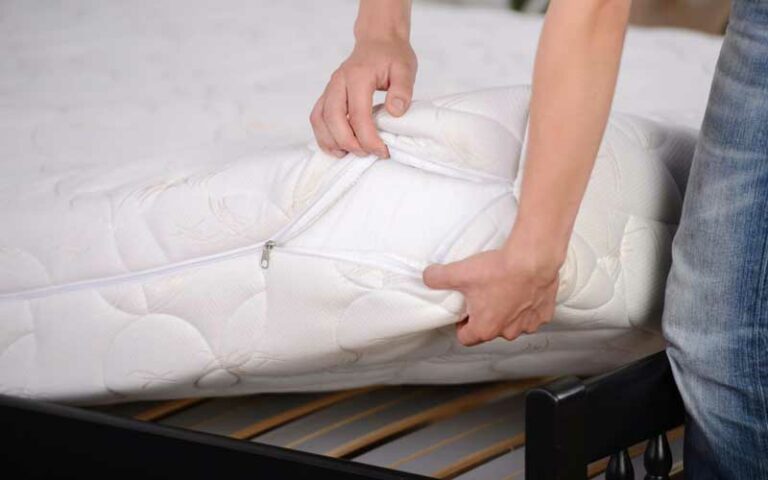A good night’s sleep is often associated with a thick mattress due to its luxury and comfort. The height of the mattress can give you a better idea of how comfortable it will be and how well it will support you each night.
The height of your bed affects your comfort because both a too thin or too thick option might lead to poor sleep and impact your health. The thickness of your mattress also affects the height of your bed, and generally speaking, the top of your mattress should be 60cm from the floor. This is considered the ideal height because our feet can reach the floor when seated at the edge of the bed, which makes it easier for us to get in and out of bed.
What to consider when deciding on mattress thickness?
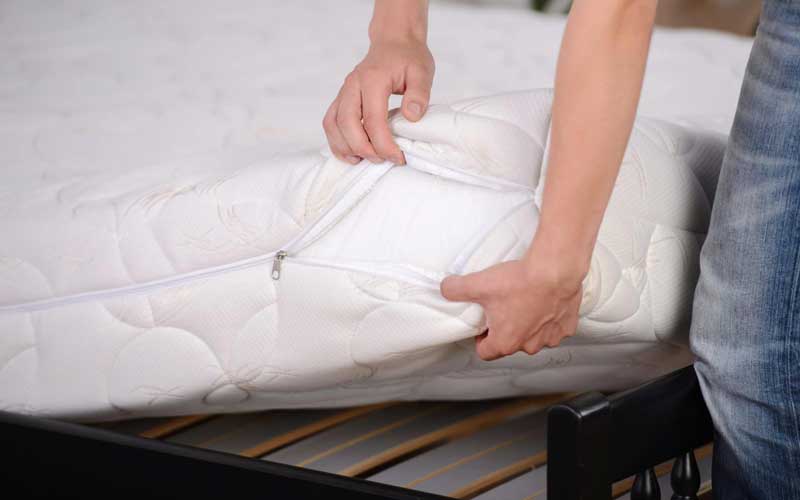
If you’re looking for a supportive, comfortable and long-lasting product, you should stay above 20 cm height. However, when you’re choosing the depth of your new bed, there are multiple factors you need to consider, such as:
Sleeping Position
As we’ve mentioned above, different thickness levels affect the feel of the mattress and that can impact your sleep quality. These levels cater to varying sleep needs and positions. For example, one sleep position can need more cushioning while another will require more support. Let’s take a closer look at each one:
- Side Sleeping – generally, side sleepers need a mattress between 30 to 35cm thick in order to receive enough cushion to the shoulders and hips. Since sleeping on your side is the most common position, most mattresses fall into this category. In addition, you need consistent support and contouring comfort. Your best bet is to choose an option that reduces pressure build-up, such as a memory foam mattress.
- Back Sleeping – people that sleep on their back should stay around 25 to 30cm in depth to support the natural curvature of their spine and prevent spinal misalignment. Back sleepers should try a pocket sprung, open coil, or even orthopaedic mattress. The reason behind this is that they provide the best care and support for natural spinal alignment while supporting your back and preventing sinkage.
- Stomach Sleeping – front sleepers need a bed that’s 25cm thick to keep their spine correctly aligned while providing a thinner comfort layer and a firmer sleeping surface. You should search for an option that distributes your weight evenly across its surface, such as a hybrid mattress.
- Combination Sleeping – combination sleepers are typically comfortable on 30 cm thick beds with a medium firmness feel. Since this type of sleeper switches to side, back, or stomach sleeping throughout the night, they need a product that can provide a balance between firmness and softness.
Body Type
Overall, the thickness of your bed and the materials used to make it usually determine how your mattress responds to your body weight. The best mattress for a good night’s rest should be supportive yet comfortable, but you should consider your body type and weight for that to happen.
- Lightweight Sleepers – are considered to be individuals that weigh less than 58 kg. Lighter people often require a thicker option (30 cm) so that the comfort layers conform to their body, relieve pressure points and reduce body aches.
- Average Sleepers – an average weight today is considered to be between 58 to 100 kg. These sleepers should make their choice depending on their sleeping position. Also, they should think about the right firmness level, which in most cases is medium-firm.
- Plus-Size Sleepers – in this category, we include heavier individuals that are above 100 kg. There are specific options designed for heavy people with thicker comfort layers and sufficient give to prevent mattress sinkage and discomfort.
- Partners – last but not least, you have to consider your partner (if you have one) when choosing a new mattress because that means more pressure compared to when sleeping alone. If you are sharing your bed with a loved one, you will most likely need a bed that’s thicker than 25cm to get the proper support you need.
Medical conditions
Suppose you have certain medical conditions like chronic back pain. In that case, you might need a firmer mattress with thinner comfort layers to support your back and prevent sinkage without losing its ability to be soft and comforting for the natural curvature of your spine.
In comparison, individuals with arthritis, shoulder pain, or hip pain need softer mattress models that will provide them with enhanced cushioning. That works best with thicker options with plusher comfort layers that conform to your curves, relieving pressure points off your shoulders, hips, and joints.
Height of bed base
Finally, you can forget about the bed base your mattress goes on top of. That’s because when deciding on the thickness, you should consider the height of your box spring, foundation, platform, or adjustable bed.
The recommended overall height of your bed, including the bed base and mattress, should not be more than 63 cm because it might limit your movements and make it harder for you to get in and out of bed. This can be an even more significant issue for people with limited mobility, such as back pain, joint pain, or arthritis.
Different mattress thickness options
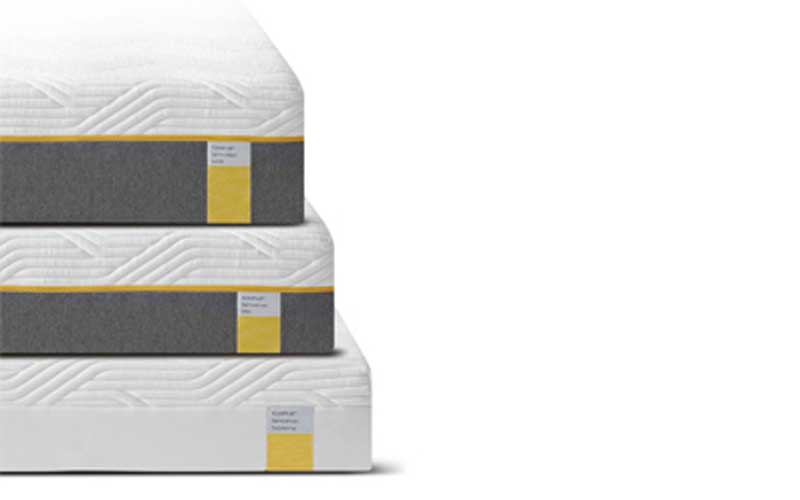
This mattress thickness guide will give you a brief overview of what to expect from your typical mattress based on thickness and why it matters.
- 5 – 12 cm – options that are this height are considered low profile mattresses. This thickness is often found in fold-away beds, crib/cot mattresses, and air mattresses. However, this isn’t a sufficient and supportive enough depth for most adults, especially if you weigh more than the average person.
- 12 – 20 cm – this choice is also known as slim mattresses. Typically they are constructed from differing foams since foams are dense and supportive, even without the added depth. They can be beneficial for individuals with limited mobility, kids, or short people due to the fact that they are easier to get into and out of.
- 20 – 30 cm – this height is considered to be the industry’s standard. Most mattresses on the market have a height of 25 cm, which can work for most sleepers and body types. Keep in mind that there is a significant difference in this height category due to the various layers in each product.
- 30 – 50 cm – today, most hybrids and newer foam mattresses fall into this height range, which is why its popularity has been growing. They are more expensive but more durable and long-lasting, which increases their value due to the better level of comfort they offer.
- 50 cm or more – products in this category are not very common and are typically made to order. You won’t find many items with a height over 50cm because they are incredibly expensive and hard to construct. Also, they are considerably heavy and cannot be compressed or shipped.
What are the benefits of a thicker mattress?
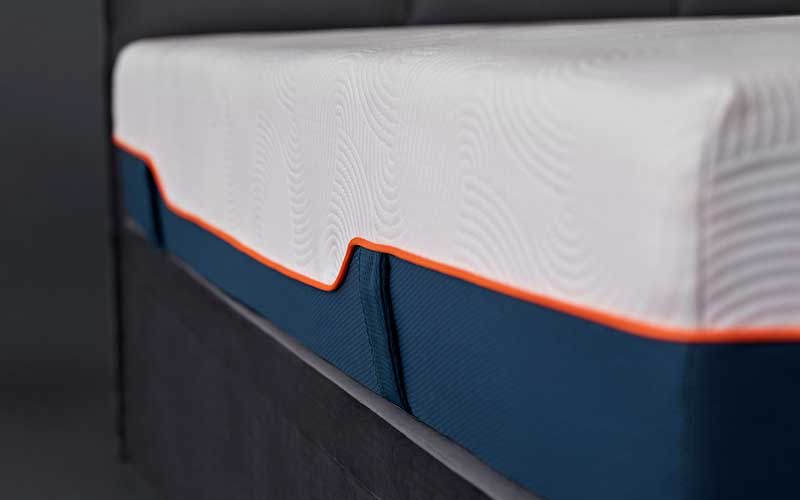
Generally speaking, a thicker mattress does not always guarantee a higher level of comfort, but there are multiple benefits regarding specific sleep needs that you might find helpful. Overall, reviews from couples and heavy people show that a thicker option is more comfortable and supportive.
Even with additional weight applied, it can still provide everything you need for a good night’s sleep. With a more significant depth come thicker comfort and base layers, as well as a generally comfortable surface, to sleep on at night.
Thick products are also more durable due to the additional material used for their construction. As a result, they typically last longer as more wear and tear is allowed before the bed starts to sag and become unusable.
Thicker beds might be beneficial during pregnancy because mobility is severely limited in women who can only sleep on their sides. Plus, bending to sit down on a low surface is increasingly challenging when you’re expecting.
What are the benefits of a thinner mattress?

Just like thicker beds, thinner mattresses come with their own advantages, which could be more suited to your specific sleep preferences. This type of item is quite popular among people with limited mobility or shorter stricter since a thinner mattress is easier to get into and out of daily.
Also, their weight is significantly lesser, making them easier to move. So, if you’re planning on constantly moving your bed and you don’t have someone to help you, a thinner version can be a good choice. Finally, the biggest benefit thinner products come with is the price. Since a lot less material is used to create a mattress, the price is lower than thicker ones.
How is a mattress constructed?
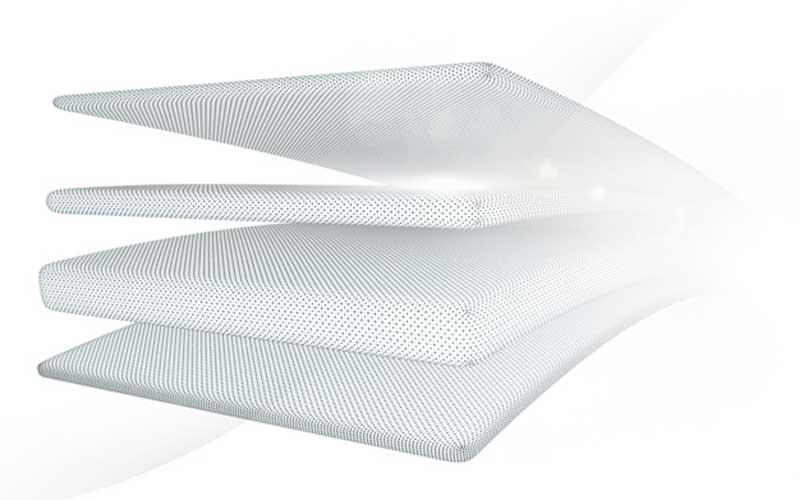
Mattresses are constructed from different materials put into layers, which, when combined, can create a blissful slumber. Those layers can be separated into two large categories, and they are base layers and comfort ones. Let’s take a close look at both groups:
Baselayer
The base layer of a mattress is its foundation. That’s what is responsible for providing overall durability and support. It is an essential layer because, without a thick enough mattress foundation, your bed will show signs of wear and tear sooner rather than later.
No one wants sags where your hips and low back lie that are so large you sink in the second you are in bed! If you’re looking for optimal performance for your foundation, this layer should be between 12 to 15 cm thick.
Comfort layers
After the base layer come all the remaining ones, also known as comfort layers. These layers contribute to healthy spine alignment, pressure relief, and motion isolation. When all these factors come together, they form a comfort trifecta that prevents endless nights of discomfort and restlessness.
Keep in mind that if your comfort layers are too thin, you won’t receive the proper support, meaning your spine won’t be properly aligned, and no pressure will be alleviated from your back, shoulders, or hips. However, you don’t want comfort layers that are too thick because that’s not ideal for the health and longevity of your spine (or your bed).
How thick is the average mattress?
The average thickness of mattresses ranges between 20 to 35 centimetres. So your best bet is to look for something with a comfort layer that’s at least 5 cm thick and a base layer with a minimum of 15 cm depth.
You can find many mattresses on the market today that have a transition layer as well, which is usually 2 to 5 cm thick. The minimum thickness needed for adequate comfort and durability is 20 cm, but the industry’s standard is 25 cm, which is why most manufacturers design beds with this depth.
Bottom line
Too thick of a mattress can make getting in and out of bed difficult, while too thin of a mattress might not be supportive enough for a restful night. If you buy a product between 25 to 35 cm, we can safely say that you’ve found the balance between too thick and too thin. Understand that each thickness level has its own pros and cons, and it’s up to you to decide what your needs and preferences are.
We hope we were able to answer the how and why on ‘Does mattress thickness matter’ and now it’s our turn to hear from you. If you have any questions regarding the subject that were left unanswered or want to share some information, we would gladly hear about it in the comments below.

